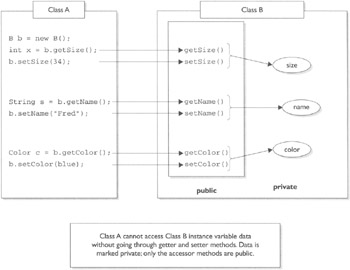Chapter 2: Object Orientation
Being a 1.5 SCJP means you must be at one with the object-oriented aspects of Java.You must dream of inheritance hierarchies, the power of polymorphism must flow through you, cohesion and loose coupling must become second nature to you, and composition must be your bread and butter. This chapter will prepare you for all of the object-oriented objectives and questions you'll encounter on the exam. We have heard of many experienced Java programmers who haven't really become fluent with the object-oriented tools that Java provides, so we'll start at the beginning.
Certification Objective —Encapsulation (Exam Objective 5.l)
5.1 Develop code that implements tight encapsulation, loose coupling, and high cohesion in classes, and describe the benefits.
Imagine you wrote the code for a class, and another dozen programmers from your company all wrote programs that used your class. Now imagine that later on, you didn't like the way the class behaved, because some of its instance variables were being set (by the other programmers from within their code) to values you hadn't anticipated. Their code brought out errors in your code. (Relax, this is just hypothetical.) Well, it is a Java program, so you should be able just to ship out a newer version of the class, which they could replace in their programs without changing any of their own code.
This scenario highlights two of the promises/benefits of Object Orientation: flexibility and maintainability. But those benefits don't come automatically. You have to do something. You have to write your classes and code in a way that supports flexibility and maintainability. So what if Java supports OO? It can't design your code for you. For example, imagine if you made your class with public instance variables, and those other programmers were setting the instance variables directly, as the following code demonstrates:
public class BadOO { public int size; public int weight; ... } public class ExploitBadOO { public static void main (String [] args) { BadOO b = new BadOO(); b.size = -5; // Legal but bad!! } } And now you're in trouble. How are you going to change the class in a way that lets you handle the issues that come up when somebody changes the size variable to a value that causes problems? Your only choice is to go back in and write method code for adjusting size (a setsize (int a) method, for example), and then protect the size variable with, say, a private access modifier. But as soon as you make that change to your code, you break everyone else's!
The ability to make changes in your implementation code without breaking the code of others who use your code is a key benefit of encapsulation. You want to hide implementation details behind a public programming interface. By interface, we mean the set of accessible methods your code makes available for other code to call—in other words, your code's API. By hiding implementation details, you can rework your method code (perhaps also altering the way variables are used by your class) without forcing a change in the code that calls your changed method.
If you want maintainability, flexibility, and extensibility (and of course, you do), your design must include encapsulation. How do you do that?
-
Keep instance variables protected (with an access modifier, often private).
-
Make public accessor methods, and force calling code to use those methods rather than directly accessing the instance variable.
-
For the methods, use the JavaBeans naming convention of set<someProperty>and get<someProperty>.
Figure 2-1 illustrates the idea that encapsulation forces callers of our code to go through methods rather than accessing variables directly.

Figure 2-1: The nature of encapsulation
We call the access methods getters and setters although some prefer the fancier terms accessors and mutators. (Personally, we don't like the word "mutate".) Regardless of what you call them, they're methods that other programmers must go through in order to access your instance variables. They look simple, and you've probably been using them forever:
public class Box { // protect the instance variable; only an instance // of Box can access it " d " "dfdf" private int size; // Provide public getters and setters public int getSize() { return size; } public void setSize(int newSize) { size = newSize; } } Wait a minute…how useful is the previous code? It doesn't even do any validation or processing. What benefit can there be from having getters and setters that add no additional functionality? The point is, you can change your mind later, and add more code to your methods without breaking your API. Even if today you don't think you really need validation or processing of the data, good OO design dictates that you plan for the future. To be safe, force calling code to go through your methods rather than going directly to instance variables. Always. Then you're free to rework your method implementations later, without risking the wrath of those dozen programmers who know where you live.
Look out for code that appears to be asking about the behavior of a method, when the problem is actually a lack of encapsulation. Look at the following example, and see if you can figure out what's going on:
class Foo { public int left = 9; public int right = 3; public void setLeft(int leftNum) { left = leftNum; right = leftNum/3; } // lots of complex test code here } Now consider this question: Is the value of right always going to be one-third the value of left? It looks like it will, until you realize that users of the Foo class don't need to use the setLeft() method! They can simply go straight to the instance variables and change them to any arbitrary int value.
EAN: 2147483647
Pages: 131